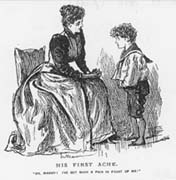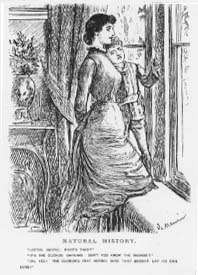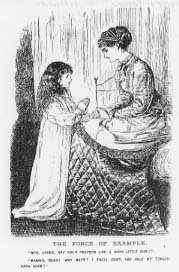Jennifer Malloy, p.5
MATERNITY
"In the normal condition of things, woman's mission is not
merely to bring forth, and suckle children, but to attend to their early education; while the father provides for the family's subsistence.
Everything that affects this normal order, necessarily induces a
perturbance in the evolution of races." -Broca on "Anthropology"
 erhaps the major argument of critics' of the suffrage movement was the notion of separate spheres and gender roles ascribed to the human race
within the natural order of mankind. The remaining three cartoons this
paper will discuss all have one thing in common. The subjects for each
portrait all consist of a mother with her child at various moments of the
day. These cartoons are the most representative of the majority of subtle
anti-feminist Punch pictures. No, there was little outright discrimination or libelous caricature in Punch cartoons in reference to the women's suffrage movement. Instead, the journal seemed intent in exhibiting women again and again, and often solely in the domestic sphere with their legal equals, children. In regard to intellect, J.M. Allan believes that "woman has ever been, is now, and ever will be, under man's guardianship.
Mentally, woman stands towards man in the relation of child to adult."
Since most of the cartoon images show women and children, the majority of
women one sees in Punch are conversing with children, implying that women
reside on the same wavelength as their offspring, but not their husbands.
erhaps the major argument of critics' of the suffrage movement was the notion of separate spheres and gender roles ascribed to the human race
within the natural order of mankind. The remaining three cartoons this
paper will discuss all have one thing in common. The subjects for each
portrait all consist of a mother with her child at various moments of the
day. These cartoons are the most representative of the majority of subtle
anti-feminist Punch pictures. No, there was little outright discrimination or libelous caricature in Punch cartoons in reference to the women's suffrage movement. Instead, the journal seemed intent in exhibiting women again and again, and often solely in the domestic sphere with their legal equals, children. In regard to intellect, J.M. Allan believes that "woman has ever been, is now, and ever will be, under man's guardianship.
Mentally, woman stands towards man in the relation of child to adult."
Since most of the cartoon images show women and children, the majority of
women one sees in Punch are conversing with children, implying that women
reside on the same wavelength as their offspring, but not their husbands.

Du Maurier's "His First Ache",Punch, Volume 99, (5, July1890), p. 2,
and his 
"Natural History", Punch, Volume 82, (6, May,1882), p. 215.
depict women with male children. This may seem innocent at first, but John Stuart Mill's commentary reveals that in Victorian society the male and his mother are only 'equal' at this low developmental stage: "People are little aware...how early the notion of his inherent superiority to a girl arises in [a boy's] mind;...how early the youth thinks himself superior to his mother, owing her perhaps forbearance, but no real respect;...is it imagined that all this does not pervert the whole manner of existence of the man, both as an individual and as a social being?"
Woman not shown discussing anything of importance with adult males can only have a debilitating effect on her legitimacy as a capable and
articulate human being.

The final cartoon, du Maurier 's "The Force of
Example", Punch,Volume 64, (5, April, 1873), p. 145, shows a mother teaching her daughter to maintain religious affinity. The information given us by the daughter about the father's lack of real religious zeal in contrast to that of his wife again plays into the Victorian cultural philosophy as the woman as
keeper of the man's religion and quest to keep the male on the right path.
on the other hand, this 'noble' responsibility doubles as a theory as to
why Victorian women should not be given voting rights, because it is said
that "women are much too under the influence of ministers of religion."
Lastly, these cartoons are intended to show as many times as possible what
sphere a woman truly belongs in. Asserting that with the advent of the
vote, women would neglect their domestic duties these cartoons are to serve
as a constant reminder of a woman's only true and valuable duty-- the
caring of their children. These images support the claims of those, like
Allan, who believe the "highest womanly type is maternity,..." and that the
"Mother has neither time nor inclination to try and pervert herself into a
poor imperfect copy of a man."
Punch and its readers have a clear understanding of the messages being produced through its cartoons. However, if the reader will notice, the
majority of drawings relative to this topic, depict well-dressed Victorian
women with one or two children, not 7 or 8, not bedraggled and poor. Jacob
Bright was once told that when asked, a lady of the upper echelon professed
to be unaware of any wrongs burdening her life that would need the
franchise to rectify. Allan as well believes that "with few exceptions,
woman suffrage finds no favor with happy wives, mothers, and all
domesticated womanly women. They have not yet discovered the frightful
grievance afflicting them. Though told they are miserable and enslaved,
they persist that they are happy and free." Bright responds to positions
such as these by asking people to take a look at the working classes of
women for whom two-dimensional images are poor propaganda-- to look at
"those women who have to meet the difficult struggle in life," and to then
decide if the vote is not really necessary for an improved quality of life.
.
Please turn to my bibliography
[Victorian initial "P" by Harlan Wallach ©copyright 1994.]
 erhaps the major argument of critics' of the suffrage movement was the notion of separate spheres and gender roles ascribed to the human race
within the natural order of mankind. The remaining three cartoons this
paper will discuss all have one thing in common. The subjects for each
portrait all consist of a mother with her child at various moments of the
day. These cartoons are the most representative of the majority of subtle
anti-feminist Punch pictures. No, there was little outright discrimination or libelous caricature in Punch cartoons in reference to the women's suffrage movement. Instead, the journal seemed intent in exhibiting women again and again, and often solely in the domestic sphere with their legal equals, children. In regard to intellect, J.M. Allan believes that "woman has ever been, is now, and ever will be, under man's guardianship.
Mentally, woman stands towards man in the relation of child to adult."
Since most of the cartoon images show women and children, the majority of
women one sees in Punch are conversing with children, implying that women
reside on the same wavelength as their offspring, but not their husbands.
erhaps the major argument of critics' of the suffrage movement was the notion of separate spheres and gender roles ascribed to the human race
within the natural order of mankind. The remaining three cartoons this
paper will discuss all have one thing in common. The subjects for each
portrait all consist of a mother with her child at various moments of the
day. These cartoons are the most representative of the majority of subtle
anti-feminist Punch pictures. No, there was little outright discrimination or libelous caricature in Punch cartoons in reference to the women's suffrage movement. Instead, the journal seemed intent in exhibiting women again and again, and often solely in the domestic sphere with their legal equals, children. In regard to intellect, J.M. Allan believes that "woman has ever been, is now, and ever will be, under man's guardianship.
Mentally, woman stands towards man in the relation of child to adult."
Since most of the cartoon images show women and children, the majority of
women one sees in Punch are conversing with children, implying that women
reside on the same wavelength as their offspring, but not their husbands.